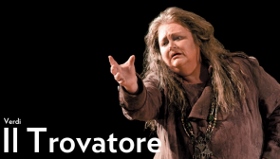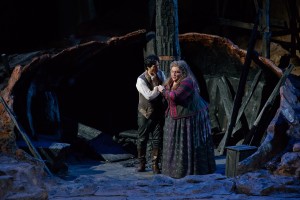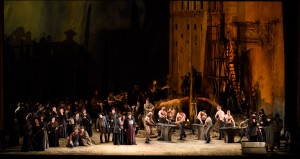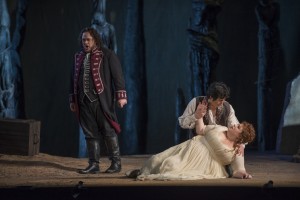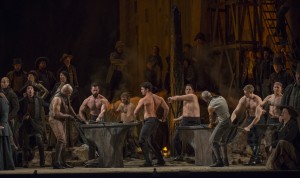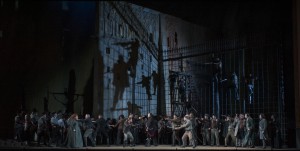A TREASURE TROVATORE
There’s nothing subtle about Verdi’s ambitiously conceived Il Trovatore (The Troubadour). Grandly realized and magnificently staged by Lyric Opera, it is one of the three triumphs of Verdi’s “middle period.” Preceded by Rigoletto, the composer followed it with La Traviata, with which it shares more than just a similar-sounding title. Both are dramatic tales of tragic love featuring demanding vocal roles and off-stage serenades sung by the lead tenor.
Based on the 1836 play El Trovador by Antonio GarcÃa Gutiérrez and adapted by Salvadore Cammarano, Il Trovatore tells a rather sprawling story in four acts involving revenge, abduction and witchcraft, as well as bands of gypsies and warring soldiers. At the center of the story is the titular troubadour Manrico, his rival the Count di Luna, and the object of their affections, Leonora. Complicating this love triangle is the gypsy Azucena, who has raised Manrico as her own child. Her story only unfolds gradually and provides the plot’s major twists and turns. Ferrando, the Count’s captain of the guard, reveals her as the daughter of a witch burned at the stake who abducted the Count’s infant brother in revenge.
In the midst of various battles enacted by scores of extras, first Leonora is rescued from the Count by Manrico, then Azucena is captured by the Count, and finally Manrico fails to rescue Azucena and is captured along with Leonora. Rather than submit to the Count, Leonora takes her own life in a futile effort to save Manrico’s. The opera’s shocking climax finally comes when Azucena reveals to the Count that Manrico, the rival he has just executed, was actually his brother.
Originally directed by David McVicar and now revived and choreographed by Leah Hausman, Lyric Opera’s production is dark and hellish. Few rays of sunshine light up Charles Edwards’ earth-toned set, which includes a life-size crucifix and a massive wall that serves as a fortress battlement, palace interior, prison gate and church clerestory, as occasion requires. Transposing the plot’s setting from fifteenth- to nineteenth-century Spain allows the production design to borrow heavily from painter Francisco Goya’s Romantic aesthetic, especially in Brigitte Reiffenstuel’s costumes. She clothes the cast in mostly monochrome military garb or simple shift dresses.
As Ferrando, Andrea Silvestrelli’s profound bass sets the standard for the impressive voices that follow, especially the two Ryan Opera Center alumni: Quinn Kelsey as Count di Luna and Amber Wagner as Leonora. Kelsey’s bravura baritone finds expression in seemingly effortless lines of incredible fluency and fulsomeness, while Wagner’s soaring soprano boasts a power that only mezzo-soprano Stephanie Blythe’s Azucena can match. The full range and pristine clarity of Wagner’s voice is displayed to maximum effect in the lilting waltz of “Di tale amor che dirsi” and the heartfelt sighs of “D’amor sull’ali rosee.”
The casting of tenor Yonghoon Lee as the titular trovatore is perhaps the only misstep in an otherwise coherent production. There is nothing wrong with Lee per se, who performs stirringly alone, but his voice isn’t as big as his fellow leads. In the trio “Di geloso amor sprezzato,” for example, Wagner and Kelsey completely drown him out. Blythe joins him rather more sensitively in the duet “Mal reggendo,” but even so it is difficult to fully appreciate Lee until his back-to-back Act 3, Scene 2 arias “Ah, sì ben mio” and “Di quella pira.” (The skinny Lee and rotund Wagner also make a rather awkward couple.)
Almost as much a vehicle for rousing choruses as for moving arias, Il Trovatore blends both extremely well. Thanks to chorus master Michael Black, Lyric Opera’s massive chorus performs a stirring rendition of the justly famous Anvil Chorus, replete with bare-chested men wielding huge hammers. Although neatly in sync, their clanging rings rather too loudly. Blythe fails to be overwhelmed by this introduction, which she easily follows with her aria “Stride la vampa,” alternating between loud and soft in a virtuosic display of volume control.
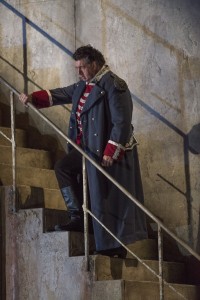 During the “Miserere” of the final act, an unseen all-male chorus approaches the transcendent with rich chant harmonies reminiscent of Rachmaninov’s All-Night Vigil. It paves the way for the supreme tragedy that follows, for Manrico, unlike Mozart’s dastardly Don Giovanni, is an innocent victim of upright character. And yet, the titular troubadour triumphs even in death where he will be reunited with his beloved Leonora. Thus, there is a breathtaking moral and artistic clarity in Verdi’s vision that cannot be found in the ambivalent Mozart and Strauss operas that preceded it this season. Viva Verdi!
During the “Miserere” of the final act, an unseen all-male chorus approaches the transcendent with rich chant harmonies reminiscent of Rachmaninov’s All-Night Vigil. It paves the way for the supreme tragedy that follows, for Manrico, unlike Mozart’s dastardly Don Giovanni, is an innocent victim of upright character. And yet, the titular troubadour triumphs even in death where he will be reunited with his beloved Leonora. Thus, there is a breathtaking moral and artistic clarity in Verdi’s vision that cannot be found in the ambivalent Mozart and Strauss operas that preceded it this season. Viva Verdi!
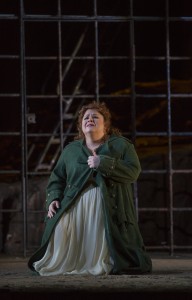 photos by Michael Brosilow and Robert Kusel
photos by Michael Brosilow and Robert Kusel
Il Trovatore
Lyric Opera of Chicago
Civic Opera House
20 N. Wacker Drive
ends on November 29, 2014
for tickets, call 312.827.5600 or visit Lyric Opera
for more shows, visit Theatre in Chicago
